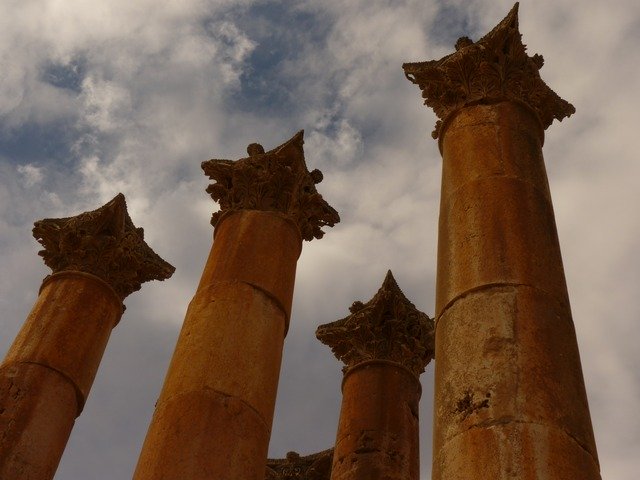تاريخ الهندوسية
| منطقات |
|
|
المفاهيم
|
|
المدارس
|
|
آلهة
|
|
ممارسات
العبادة
سمسكارا
ڤارناشراا دهارما
مهرجانات
|
|
فلاسفة
|
|
تاريخ الهندوسية يشير إلى تشكيلة واسعة من الطوائف الهندوسية المترابطة التي نشأت في شبه القارة الهندية، ومعظمهم يتواجد في ما اليوم الهند ونـِپال وپاكستان وبنگلادش وأفغانستان. ويوجد أتباع أيضاً في جزيرة بالي الإندونيسية. ويتراكب تاريخها أويتزامن مع تطور الديانات الهندية منذ الهند في العصر الحديدي. ولذلك فينطق عنها أنه "أقدم ديانة حية" في العالم. ويعتبر الدارسون الهندوسية كتخليق من ثقافات وتنطقيد هندية مختلفة، بجذور متباينة بدون مؤسس واحد أومصدر واحد.
تاريخ الهندوسية is often divided into periods of development, with the first period being that of the الديانة الڤيدية التاريخية التي تعود إلى ما بين 1900 ق.م. و1400 ق.م.. The subsequent period, between 800 BCE and 200 BCE, is "a turning point between the Vedic religion and Hindu religions", and a formative period for Hinduism, Jainism and Buddhism. The Epic and Early Puranic period, from c. 200 BCE to 500 CE, saw the classical "Golden Age" of Hinduism (c. 320-650 CE), which coincides with the Gupta Empire. In this period the six branches of Hindu philosophy evolved, namely Samkhya, Yoga, Nyaya, Vaisheshika, Mīmāṃsā, and Vedanta. Monotheistic sects like Shaivism and Vaishnavism developed during this same period through the Bhakti movement. The period from roughly 650 to 1100 CE forms the late Classical period or early Middle Ages, in which classical Puranic Hinduism is established, and Adi Shankara's Advaita Vedanta, which incorporated Buddhist thought into Vedanta, marking a shift from realistic to idealistic thought.
شهدت الهندوسية تحت حكم كلٍ من الحكام الهندوس والمسلمين منذ ح. 1200 إلى 1750م، أهمية متزايدة لحركة باكتي، التي مازالت مؤثرة حتى اليوم. The colonial period saw the emergence of various حركات الإصلاح الهندوسية partly inspired by western movements, such as Unitarianism and Theosophy. The Partition of India in 1947 was along religious lines, with the Republic of India emerging with a Hindu majority. During the 20th century, due to the Indian diaspora, Hindu minorities have formed in all continents, with the largest communities in absolute numbers in the United States and the United Kingdom. In the Republic of India, Hindu nationalism has emerged as a strong political force since the 1980s, the Hindutva Bharatiya Janata Party forming the Government of India from 1999 to 2004, and its first state government in South India in 2006, and also the Narendra Modi led Government from 2014.
جذور الهندوسية
الديانة الهندية - براهما، فشنو، شيفا - كرشنا - كالي الآلهة الحيوانية - البقرة المقدسة - تعدد الآلهة والوحدانية
لم تكن الديانة الهندية التي حلت محل البوذية ديانة واحدة، كلا ولا كانت مقتصرة على كونها عقيدة دينية؛ بل كانت خليطاً من عقائد وطقوس لا يشهجر القائمون بها في أكثر من أربع صفات؛ فهم يعترفون بنظام الطبقات وبزعامة البراهمة، وهم يقدسون البقرة باعتبارها تمثل الألوهية على نحوتمتاز به من سواها، وهم يقبلون قانون "كارما" وتناسخ الأرواح، وهم يضيفون إلى آلهتهم الجديدة آلهة الفيدات؛ ولقد كان بعض هذه العقائد أسبق من عبادة الطبيعة التي اتىت بها الفيدا، كما ظلت قائمة بعد زوال تلك العبادة، وأما بعضها الآخر فقد نشأ من حتى البراهمة كانوا يغضون أبصارهم عن ضروب من الطقوس والآلهة والعقائد لم ينص عليها كتابهم المقدس، بل تناقضه روح الفيدا مناقضة ليست باليسيرة؛ فأتيحت الفرصة لتلك العقائد حتى تنضج في وعاء الفكر الديني عند الهنود، ومضت في نضجها ذاك حتى في الفترة العابرة التي ارتفعت فيها البوذية إلى مكان السيادة العقلية في البلاد.
كان آلهة العقيدة الهندية يتميزون بكثرة أعضائهم الجسدية التي يمثلون بها على نحوغامض قدرتهم الخارقة في الفهم والنشاط والقوة؛ "فبراهما" الجديد كان له أربعة وجوه، وكان لـ "كارتكيا" ستة وجوه، ولـ "شيفا" ثلاثة أعين، ولـ "هندرا" ألف عين؛ وكل إله عندهم تقريباً كان له أربع أذرعة(10) وعلى رأس هذه المجموعة الجديدة من الآلهة "براهما" الذي كان له من الشهامة ما أبعده عن الميل مع الهوى، وهوسيد الآلهة المعترف له بتلك السيادة، على الرغم من أنه مهمل في شعائر العبادة العملية إهمال الملك الدستوري في أوربا الحديثة؛ و"براهما" و"شيفا" و"فشنو" هم الثلاثة الآلهة (لا الثالوث) الذي يسيطرون على الكون، وأما "فشنو" فهوإله الحب الذي كثيراً ما انقلب إنسانا ليتقدم بالعون إلى بني الإنسان؛ وأعظم من يتجسد فيه "فشنو" هو"كرشنا" ، وهوفي صورته "الكرشنية" هذه، قد ولد في سجن وأتى بكثير من أعاجيب البطولة والغرام، وشفى الصم والعمي، وعاون المصابين بداء البرص، وذاد عن الفقراء، وبعث الموتى من قبورهم؛ وكان له تلميذ محبب إلى نفسه، وهو"أرجونا" ، وأمام "أرجونا" تبدلت خلقة "فشنو" حالاً بعد حال؛ ويزعم بعض الرواة أنه توفي مطعوناً بسهم، ويزعم آخرون أنه اغتال مصلوباً على شجرة؛ وهبط إلى جهنم ثم صعد إلى السماء، على حتى يعود في اليوم الآخر ليحاسب الناس أحياءهم وأمواتهم(11).
الحياة، بل الكون كله، لها في رأي الهندي ثلاثة وجوه رئيسية: الخلق، والاحتفاظ بالمخلوق، ثم الفناء؛ ومن ثم كان للألوهية عنده ثلاث صور: براهما الخالق، وفشنوالحافظ، وشيفا المدمر؛ تلك هي "الأشكال الثلاثة" التي يقدسها الهنود أجمعين ماعدا الجانتيين منهم ؛ والناس منقسمون بحبهم طائفتين: إحداهما تميل إلى ديانة فشنو، والأخرى إلى ديانة شيفا؛ وكلتا العقيدتين بمثابة الجارتين المسالمتين، بل قد تتقدم كلتاهما بالقرابين في معبد واحد(13)، والحكماء من البراهمة- تتبعهم الأكثرية العظمى من سواد الناس- تكرم الإلهين معاً بغير تمييز لأحدهما؛ أما الفشنيون الأتقياء فيرسمون على جباههم جميع صباح بالطين الأحمر علامة فشنو، وهي شوكة ذات أسنان ثلاث؛ وأما الشيفيون المخلصون لعقيدتهم فيرسمون ثلاثة خطوط أفقية على جباههم برماد من روث البقر، أويلبسون "اللنجا"- رمز عضوالذكورة- ويربطونه على أذرعتهم أويعلقونه حول أعناقهم(14).
وعبادة "شيفا" هي من أقدم وأعمق وأبشع العناصر التي منها تتألف الديانة الهندية؛ فيقدم لنا "سير جون مارشل" "دليلاً لا يأتيه الباطل" على حتى عقيدة "شيفا" كانت موجودة في "موهنجو- دارو"، متخذة أحياناً صورة شيفا ذي الرءوس الثلاثة، وأحياناً أخرى صورة أعمدة حجرية صغيرة، يزعم لنا أنها ترمز لعضوالذكورة على نحوما ترمز له عندهم بدائلها في العصر الحديث؛ وهويخلص من ذلك إلى نتيجة هي حتى "العقيدة الشيفية أقدم عقيدة حية في العالم كله" . واسم الإله- أعني حدثة شيفا- لفظة أريد بها التخفيف من بشاعة هذا الإله، فالحدثة شيفا معناها الحرفي "العطوف" مع حتى شيفا في حقيقة الأمر إله القسوة والتدمير قبل جميع شئ آخر؛ هوتجسيد لتلك القوة الكونية التي تعمل واحدة بعد أخرى، على تخريب جميع الصور التي تتبدى فيها حقيقة الكون- جميع الخلايا الحية وجميع الكائنات العضوية، وكل الأنواع، وكل الأفكار وكل ما أبدعته يد الإنسان، وكل الكواكب، وكل شيء؛ ولم يسبق الهنود شعب قط في شجاعتهم في لقاءة الحقيقة التي هي عدم ثبات الأمور على صورها ووقوف الطبيعة من جميع شئ موقف الحياد، لقاءة صريحة ؛ولم يسبقهم شعب قط في اعترافهم اعترافاً واضحاً بأن الشر يتوازن مع الخير، والهدم يساير الخلق خطوة خطوة، وأن ولادة الأحياء بأسرها جريمة كبرى عقابها الموت؛ فالهندي الذي تعذبه آلاف العوامل من عثرة الحظ والآلام، يرى في تلك الألوان من التعذيب أثراً ينم عن قوة نشيطة يمتعها- فيما يظهر- حتى تحطم جميع ما أنتجه براهما، وهوالقوة الخالقة في الطبيعة؛ إذا "شيفا" ليطرب راقصاً إذا ما سمع نغمة العالم فأدرك منها عالماً لا يني يتكون وينحل ويعود إلى التكون من جديد.
ولكن كما حتى الموت عقوبة الولادة، فكذلك الولادة تخييب لراتى الموت؛ فالإله نفسه الذي يرمز للتدمير، يمثل كذلك للعقل الهندي تلك الدفعة الجارفة نحوالتناسل الذي يتغلب على موت الفرد باستمرار الجنس؛ وهذه الحيوية الخلاقة الناسلة (شاكتي) التي يبديها شيفا- أوالطبيعة- تتمثل في بعض جهات الهند، وخصوصاً في البنغال، في صورة زوجة شيفا، واسمها "كالي" (بارفاتي، أوأوما أودرجا) وهي موضع عبادة في عقيدة من العقائد الكثيرة التي تأخذ بممضى "الشاكتي" هذا؛ ولقد كانت هذه العبادة- حتى القرن الماضي- وحشية الطقوس كثيراً ما تتضمن في شعائرها تضحية بشرية، لكن الآلهة اكتفت بعدئذ بضحايا الماعز(17)؛ وهذه الآلهة صورتها عند عامة الناس شبح أسود بفم مفغور ولسان متدل، تزدان بالأفاعي وترقص على جثة ميتة؛ وأقراطها رجال موتى، وعقدها سلسلة من جماجم، ووجهها وثدياها تلطخها الدماء(18) ومن أيديها الأربعة يدان تحملان سيفاً ورأساً مبتوراً، وأما اليدان الأخريان فممدودتان رحمة وحماية؛ لأن "كالي- بارفالي" هي كذلك الإله الأمومة كما أنها عروس الدمار والموت؛ وفي وسعها حتى تكون رقيقة الحاشية كما في وسعها حتى تكون قاسية، وفي مقدورها حتى تبتسم كما في مقدورها حتى تقتل؛ ولعلها كانت ذات يوم إلهة أماً في سومر، ومن ثم اتىت إلى الهند قبل حتى تتخذ هذا الجانب البشع من جانبيها(19) ولاشك أنها هي وزوجها قد اتخذا أبشع صورة ممكنة لكي يلقيا الرعب في نفوس الرعاديد من عبادها فيحتشموا، أوقد تكون هذه البشاعة كلها قد أريد بها حتى يلقي الرعب في نفوس العباد فيجودوا بالعطاء للكهنة .
تلك هي أعظم آلهة الهندوسيين، لكنا لم نذكر إلا خمسة من ثلاثين مليوناً من الآلهة تزدحم بها مقبرة العظماء في الهند؛ ولوأحصينا أسماء هاتيك الآلهة لاقتضى ذلك مائة مجلد؛ وبعضها أقرب في طبيعته إلى الملائكة، وبعضها هوما قد نسميه نحن بالشياطين، وطائفة منها أجرام سماوية مثل الشمس، وطائفة منها تمائم مثل "لاكشمي" (إلهة الحظ الحسن)، وكثير منها هي حيوانات الحقل أوطيور السماء؛ فالهندي لا يرى فارقاً بعيداً بين الحيوان والإنسان، فالحيوان روح كما للإنسان، والأرواح تمضي دواماً متنقلة من بني الإنسان إلى بني الحيوان، ثم تعود إلى بني الإنسان مرة أخرى؛ وكل هذه الصنوف الإلهية قد نسجت خيوطها في شبكة واحدة لا نهاية لحدودها، هي "كارما" وتناسخ الأرواح؛ فالفيل مثلاً قد أصبح الإله "جانيشا" واعتبروه ابن شيفا(21)، وفيه تتجسد طبيعة الإنسان الحيوانية، وكانت صورته في الوقت نفسه تتخذ طلسماً يقي حامله من الحظ السيئ؛ كذلك كانت القردة والأفاعي مصدر رعب، فكانت لذلك من طبيعة الآلهة؛ فالأفعى التي تؤدي عضة واحدة منها إلى موت سريع، واسمها "ناجا" كان لها عندهم قدسية خاصة؛ وترى الناس في كثير من أجزاء الهند يقيمون جميع عام حفلاً دينياً تكريماً للأفاعي، ويقدمون العطايا من اللبن والموز لأفاعي "الناجا" عند مداخل جحورها(22)؛ كذلك أقيمت المعابد تمجيداً للأفاعي كما هي الحال في شرقي ميسور، وهناك في هذه المعابد تسكن جموع زاخرة من الزواحف، ويقوم الكهنة على إطعامها والعناية بها(23)؛ وللتماسيح والنمور والطواويس والببغاوات، بل والفئران حقها من العبادة(24).
وأكثر الحيوان قدسية عند الهندي هي البقرة، فنرى تماثيل الثيرة مصنوعة من جميع مادة وفي شتى الأحجام تراها في المعابد والمنازل وميادين المدن؛ وأما البقرة نفسها فأحب الكائنات الحية جميعاً إلى الهنود، ولها مطلق الحرية في ارتياد الطرقات كيف من الممكن أن شاءت، وروثها يستخدم وقوداً أومادة مقدسة يتبركون بها، وبولها خمر مقدس يطهر جميع ما في الجسم من نجاسة في الظاهر والباطن؛ ولا يجوز للهندي تحت أي ظرف حتى يأكل لحمها أوحتى يصطنع من جلدها لباساً يرتديه- فلا يصنع منه غطاء للرأس ولا قفازاً ولا حذاء؛ وإذا ماتت البقرة وجب دفنها بجلال الطقوس الدينية(25)، ولعل السياسة الحكيمة هي التي رسمت فيما مضى هذا التحريم احتفاظاً للزراعة بحيوان الجر حتى يسد حاجة السكان الذين يتكاثرون(26)، وقد بلغ عدد البقر اليوم ربع عدد السكان(27) ووجهة نظر الهندي في ذلك هي أنه ليس أبعد عن المعقول حتى تشعر بالحب العميق للبقرة والمقت الشديد لفكرة أكلها، من حتى تكن أمثال هذه المشاعر للحيوانات المستأنسة من قطط وكلاب، لكن الذي يبعث على السخرية المرة في الأمر هوعقيدة البراهمة بأن الأبقار لا يجوز ذبحها قط، وأن الحشرات لا يحل إيذاؤها قط، وأن الأرامل من النساء ينبغي حتى يحرقن أحياء؛ فحقيقة الأمر هي حتى عبادة الحيوان قد ظهرت في تاريخ الشعوب كلها، فإن جاز للإنسان حتى يؤلمه الحيوان اطلاقاً، فالبقرة الرحيمة الهادئة حقها في هذا التقديس؛ ولا يجوز لنا حتى نغلوفي كبريائنا حين تأخذنا الدهشة لهذه المعارض الحيوانية من آلهة الهنود، فلنا كذلك إبليس عدن في صورة حية، والثور المضىي في العهد القديم من الإنجيل، والسمك المقدس في سراديب الموتى، وحمل الله الوديع.
إن سر تعدد الآلهة هوعجز العقل الساذج عن التفكير فيما ليس مشخصاً؛ فأيسر عليه حتى يفهم الأشخاص من حتى يعقل القوى، وأن يفهم الإرادات من حتى يتصور القوانين(28)، والظن عند الهندي هوحتى حواسنا البشرية لا ترى من الحوادث التي تدركها سوى ظاهرها، ويعتقد حتى وراء هذه الظواهر كائنات روحية لا حصر لعددها، يمكن إدراكها بالعقل لا بالحواس- على حد تعبير "كانت"؛ ولقد أدى تسامح البراهمة ذوالمسحة الفلسفية، إلى الزيادة من ذخيرة آلهتهم حتى ازدادت كثرة على كثرة، وذلك حتى الآلهة المحليين وآلهة القبائل المتنوعة قد صادفت عند الهندي سهلاً ومرحباً، فقبلها وفسرها بأنها جميعاً تصور جوانب من آلهته الأصلية؛ فكل عقيدة يسمح لها بالدخول عندهم إذا كان في مستطاعها حتى تدفع الضريبة على ذلك؛ حتى كاد جميع إله آخر الأمر حتىقد يكون صورة أوصفة أوتجسيداً لإله آخر، ثم تناول العقل الهندي الرشيد جميع هذه الآلهة فدمجها في إله واحد؛ هكذا تحول تعدد الآلهة إلى عقيدة بوحدة الوجود، أوشكت عندهم حتى تكون توحيداً، والتوحيد بدوره أوشك حتىقد يكون عندهم واحدية فلسفية؛ فكما يتوجه المسيحي الورع بالنادىء إلى العذراء، أوإلى قديس من آلاف القديسين ومع ذلك لا يتحول عن توحيده لله، بمعنى أنه لا يعترف إلا بإله واحد على أنه ذوالجلال الأسمى، فكذلك الهندي يتوجه بالنادىء إلى "كالي" أو"راما" أو"كرشنا" أو"جانيشا" دون حتى يتطرق إلى ذهنه لحظة واحدة حتى هذه آلهة لها السيادة العليا فترى بعض الهنود يتخذ من "فشنو" إلهاً أعلى، وبعضهم يتخذ من "شيفا" إلهاً أعلى، ويجعل فشنوأحد ملائكته؛ وإذا وجدت بين الهنود أقلية تعبد "براهما" فما ذلك إلا لأنه مجرد عن التشخص، ممتنع على الحواس، بعيد عن البشر، ولهذا السبب عينه ترى معظم الكنائس في البلاد المسيحية قد أقيمت تكريماً لمارية أولأحد القديسين، وكان على المسيحية حتى تنتظر حتى يجيئها فولتير فيقيم معبداً لله.
انظر أيضاً
- تاريخ الهند
- تاريخ اليوگا
- History of Shaivism
- الديانات الهندية
- الدين في الهند
ملاحظات
-
^ See:
- "أقدم ديانة":
- Fowler (1997, p. 1): "ربما أقدم ديانة في العالم"
- Gellman & Hartman (2011): "الهندوسية، أقدم ديانة في العالم"
- Stevens (2001, p. 191): "الهندوسية، أقدم ديانة في العالم"
- "أقدم ديانة حية" (Sarma 1987, p. 3)
- "أقدم ديانة رئيسية حية" في العالم (Merriam-Webster 2000, p. 751; Klostermaier 2007, p. 1)
- Laderman (2003, p. 119): "world's oldest living civilisation and religion"
- Turner (1996-B, p. 359): "It is also recognized as the oldest major religion in the world"
- Urreligion, Shamanism, Animism, Ancestor worship for some of the oldest forms of religion
- Sarnaism and Sanamahism, Indian Tribal religions connected to the earliest migrations into India
- Australian Aboriginal mythology, one of the oldest surviving religions in the world.
- "أقدم ديانة":
-
^ وبين جذورها نجد:
- الديانة الڤيدية (Flood 1996, p. 16) من الفترة الڤيدية المتأخرة ووهجريزها على مكانة البراهمان (Samuel 2010, pp. 48–53)، ولكن أيضاً
- the religions of the Indus Valley Civilisation (Narayanan 2009, p. 11, Lockard 2007, p. 52, Hiltebeitel 2007, p. 3, Jones & Ryan 2006, p. xviii),
- the Sramana or renouncer traditions (Gomez 2013, p. 42, Flood 1996, p. 16) of north-east India (Gomez 2013, p. 42), and
- "popular or local traditions" (Flood 1996, p. 16)
- ^ There is no exact dating possible for the beginning of the Vedic period. Witzel mentions a range between 1900 and 1400 BCE. Flood mentions 1500 BCE.
ملاحظات فرعية
الهامش
- ^ Brodd 2003.
- ^ Lockard 2007, p. 50.
- ^ Hiltebeitel 2007, p. 12.
- ^ Samuel 2010, p. 193.
- ^ Flood 1996, p. 16.
- ^ Narayanan 2009, p. 11.
- ^ Osborne 2005, p. 9.
- ^ Michaels 2004, p. 32-36.
- ^ Witzel 1995, p. 3-4.
- ^ Flood 1996, p. 21.
- ^ Michaels 2004, p. 38.
- ^ Michaels 2004.
- ^ Blackwell's History of India; Stein 2010, page 107
- ^ Some Aspects of Muslim Administration, Dr. R.P.Tripathi, 1956, p.24
المصادر
المطبوعة
- Allchin, Frank Raymond; Erdosy, George (1995), The Archaeology of Early Historic South Asia: The Emergence of Cities and States, Cambridge University Press, https://books.google.com/books?id=EfZRVIjjZHYC, retrieved on 2008-11-25
- Anthony, David W. (2007), The Horse The Wheel And Language. How Bronze-Age Riders From the Eurasian Steppes Shaped The Modern World, Princeton University Press
- Avari, Burjor (2013). Islamic Civilization in South Asia: A history of Muslim power and presence in the Indian subcontinent. Routledge. ISBN .
- Ayalon, David (1986), Studies in Islamic History and Civilisation, BRILL, ISBN 965-264-014-X
- Banerji, S. C. (1992), Tantra in Bengal (Second Revised and Enlarged ed.), Delhi: Manohar, ISBN 81-85425-63-9
- Basham, Arthur Llewellyn (1989), The Origins and Development of Classical Hinduism, Oxford University Press, https://books.google.com/books?id=2aqgTYlhLikC&dq=history+of+hinduism&hl=nl&source=gbs_navlinks_s
- Basham, A.L (1999), A Cultural History of India, Oxford University Press, ISBN 0-19-563921-9
- Beckwith, Christopher I. (2009), Empires of the Silk Road, Princeton University Press, ISBN 0691135894
- Beversluis, Joel (2000), Sourcebook of the World's Religions: An Interfaith Guide to Religion and Spirituality (Sourcebook of the World's Religions, 3rd ed), Novato, Calif: New World Library, ISBN 1-57731-121-3
- Bhaktivedanta, A. C. (1997), Bhagavad-Gita As It Is, Bhaktivedanta Book Trust, ISBN 0-89213-285-X, http://bhagavadgitaasitis.com/, retrieved on 14 July 2007
- Bhaskarananda, Swami (1994), The Essentials of Hinduism: a comprehensive overview of the world's oldest religion, Seattle, WA: Viveka Press, ISBN 1-884852-02-5
- Bhattacharya, Vidhushekhara (1943), Gauḍapādakārikā, Delhi: Motilal Banarsidass
- Bhattacharyya, N.N (1999), History of the Tantric Religion (Second Revised ed.), Delhi: Manohar publications, ISBN 81-7304-025-7
- Bowker, John (2000), The Concise Oxford Dictionary of World Religions, Oxford University Press
- Brodd, Jefferey (2003), World Religions, Winona, MN: Saint Mary's Press, ISBN 978-0-88489-725-5
- Bryant, Edwin (2007), Krishna: A Sourcebook, Oxford University Press
- Burley, Mikel (2007), Classical Samkhya and Yoga: An Indian Metaphysics of Experience, Taylor & Francis
- Cavalli-Sforza, Luigi Luca; Menozzi, Paolo; Piazza, Alberto (1994), The History and Geography of Human Genes, Princeton University Press, https://books.google.com/books?id=FrwNcwKaUKoC&dq=Australoid+india&hl=nl&source=gbs_navlinks_s
- Chidbhavananda, Swami (1997), The Bhagavad Gita, Sri Ramakrishna Tapovanam
- Clarke, Peter Bernard (2006), New Religions in Global Perspective, Routledge, p. 209, ISBN 0-7007-1185-6
- Clark, Sharri R. (2007), The social lives of figurines: recontextualising the third millennium BCE terracotta figurines from Harappa, Pakistan. Harvard PhD
- Comans, Michael (2000), The Method of Early Advaita Vedānta: A Study of Gauḍapāda, Śaṅkara, Sureśvara, and Padmapāda, Delhi: Motilal Banarsidass
- Cordaux, Richard; Weiss, Gunter; Saha, Nilmani; Stoneking, Mark (2004), "The Northeast Indian Passageway: A Barrier or Corridor for Human Migrations?", Molecular Biology and Evolution (Society for Molecular Biology and Evolution) 21: 1525–33, doi:, PMID 15128876, http://mbe.oxfordjournals.org/cgi/content/abstract/21/8/1525, retrieved on 25 November 2008
- Cousins, L.S. (2010), Buddhism. In: "The Penguin Handbook of the World's Living Religions", Penguin, https://books.google.com/books?id=bNAJiwpmEo0C&dq=%22hindu+synthesis%22&hl=nl&source=gbs_navlinks_s
- Crangle, Edward Fitzpatrick (1994), The Origin and Development of Early Indian Contemplative Practices, Otto Harrassowitz Verlag
- Doniger, Wendy (1999), Merriam-Webster's Encyclopedia of World Religions, Merriam-Webster, https://books.google.com/books?id=ZP_f9icf2roC&hl=nl&source=gbs_navlinks_s
- Doniger, Wendy (2010), The Hindus: An Alternative History, Oxford University Press, https://books.google.com/books?id=nNsXZkdHvXUC&printsec=frontcover&dq=history+of+hinduism&hl=nl&sa=X&ei=JMs5UqiDD-Od0QXMkoGwBg&ved=0CEsQ6AEwAg#v=onepage&q=history%20of%20hinduism&f=false
- Duchesne-Guillemin, Jacques (1963), "Heraclitus and Iran", History of Religions 3 (1): 34–49, doi:
- Eaton, Richard M. (1993), The Rise of Islam and the Bengal Frontier, 1204–1760, University of California Press, http://publishing.cdlib.org/ucpressebooks/view?docId=ft067n99v9;brand=ucpress
- Eaton, Richard M. (2000a), "Temple desecration in pre-modern India. Part I", Frontline, http://www.columbia.edu/itc/mealac/pritchett/00islamlinks/txt_eaton_temples1.pdf
- Eaton, Richard M. (2006), "Introduction", Slavery and South Asian History, Indiana University Press 0-2533, ISBN 0-253348102
- Eliot, Sir Charles (2003), Hinduism and Buddhism: An Historical Sketch, I (Reprint ed.), Munshiram Manoharlal, ISBN 81-215-1093-7
- Embree, Ainslie T. (1988), Sources of Indian Tradition. Second Edition. volume One. From the beginning to 1800, Columbia University Press
- Esposito, John (2003), "Suhrawardi Tariqah", The Oxford Dictionary of Islam, Oxford University Press, ISBN 978-0195125597
- Feuerstein, Georg (2002), The Yoga Tradition, Motilal Banarsidass, ISBN 3-935001-06-1
- Flood, Gavin D. (1996), An Introduction to Hinduism, Cambridge University Press
- Flood, Gavin (2006), The Tantric Body. The Secret Tradition of Hindu Religion, I.B Taurus
- Flood, Gavin (2008), The Blackwell Companion to Hinduism, John Wiley & Sons
- Fort, Andrew O. (1998), Jivanmukti in Transformation: Embodied Liberation in Advaita and Neo-Vedanta, SUNY Press
- Fowler, Jeaneane D. (1997), Hinduism: Beliefs and Practices, Sussex Academic Press
- Fuller, C. J. (2004), The Camphor Flame: Popular Hinduism and Society in India, Princeton, NJ: Princeton University Press, ISBN 978-0-691-12048-5
- Gaborieau, Marc (June 1985), "From Al-Beruni to Jinnah: Idiom, Ritual and Ideology of the Hindu-Muslim Confrontation in South Asia", Anthropology Today (Royal Anthropological Institute of Great Britain and Ireland) 1 (3): 7–14, doi:
- Garces-Foley, Katherine (2005), Death and religion in a changing world, M. E. Sharpe
- Garg, Gaṅgā Rām (1992), Encyclopaedia of the Hindu World, Volume 1, Concept Publishing Company, ISBN 9788170223740, https://books.google.com/?id=w9pmo51lRnYC&dq=first+mention+of+the+word+sindhu
- Gellman, Marc; Hartman, Thomas (2011), Religion For Dummies, John Wiley & Sons
- Georgis, Faris (2010), Alone in Unity: Torments of an Iraqi God-Seeker in North America, Dorrance Publishing, ISBN 1-4349-0951-4, https://books.google.com/books?id=vFZrxLjtiI8C&pg=PA62
- Ghurye, Govind Sadashiv (1980), The Scheduled Tribes of India, Transaction Publishers, ISBN 9781412838856, https://books.google.com/?id=pTNmCIc9hCUC&dq=australoids+india+religion
- Gombrich, Richard F. (2006), Theravada Buddhism. A Social History from Ancient Benares to Modern Colombo (Second ed.), London and New York: Routledge
- Gomez, Luis O. (2013), Buddhism in India. In: Joseph Kitagawa, "The Religious Traditions of Asia: Religion, History, and Culture", Routledge, ISBN 9781136875908, https://books.google.com/books?id=9fyzAAAAQBAJ&pg=PA42
- Grapperhaus, F.H.M. (2009), Taxes through the Ages, ISBN 978-9087220549
- Growse, Frederic Salmon (1996), Mathura - A District Memoir (Reprint ed.), Asian Educational Services
- Halbfass, Wilhelm (1991), Tradition and Reflection, SUNY Press, ISBN 9780791403617, https://books.google.com/?id=-5fImMZMqNIC
- Halbfass, Wilhelm (1995), Philology and Confrontation: Paul Hacker on Traditional and Modern Vedānta, SUNY Press
- Halbfass, Wilhelm (2007), Research and reflection: Responses to my respondents / iii. Issues of comparative philosophy (pp. 297-314). In: Karin Eli Franco (ed.), "Beyond Orientalism: the work of Wilhelm Halbfass and its impact on Indian and cross-cultural studies" (1st Indian ed.), Delhi: Motilal Banarsidass Publishers, ISBN 8120831101, https://books.google.com/books?id=tv-4tyO9u_QC
- Harman, William (2004), "Hindu Devotion", in Rinehart, Robin, Contemporary Hinduism: Ritual, Culture, and Practice, ABC-CLIO, ISBN 1576079058
- Harshananda, Swami (1989), A Bird's Eye View of the Vedas, in "Holy Scriptures: A Symposium on the Great Scriptures of the World" (2nd ed.), Mylapore: Sri Ramakrishna Math, ISBN 81-7120-121-0
- Hardy, P. (1977), "Modern European and Muslim explanations of conversion to Islam in South Asia: A preliminary survey of the literature", Journal of the Royal Asiatic Society of Great Britain & Ireland 109 (2): 177–206, doi:
- Harvey, Andrew (2001), Teachings of the Hindu Mystics, Shambhala, ISBN 1-57062-449-6
- Hiltebeitel, Alf (2002), Hinduism. In: Joseph Kitagawa, "The Religious Traditions of Asia: Religion, History, and Culture", Routledge, ISBN 9781136875977, https://books.google.com/books?id=kfyzAAAAQBAJ&printsec=frontcover
- Hiltebeitel, Alf (2007), Hinduism. In: Joseph Kitagawa, "The Religious Traditions of Asia: Religion, History, and Culture". Digital printing 2007, Routledge, ISBN 9781136875908, https://books.google.com/?id=9fyzAAAAQBAJ
- Hoiberg, Dale (2001), Students' Britannica India, Popular Prakashan, ISBN 0-85229-760-2
- Hopfe, Lewis M.; Woodward, Mark R. (2008), Religions of the World, Pearson Education, ISBN 9780136061779, https://books.google.com/books?id=BVbiMBDVrdEC&pg=PA79
- Hori, Victor Sogen (1994), Teaching and Learning in the Zen Rinzai Monastery. In: Journal of Japanese Studies, Vol.20, No. 1, (Winter, 1994), 5-35, http://www.essenes.net/pdf/Teaching%20and%20Learning%20in%20the%20Rinzai%20Zen%20Monastery%20.pdf[]
- Inden, Ronald (1998), Ritual, Authority, And Cycle Time in Hindu Kingship. In: JF Richards, ed., "Kingship and Authority in South Asia", New Delhi: Oxford University Press
- Inden, Ronald B. (2000), Imagining India, C. Hurst & Co. Publishers
- Johnson, W.J. (2009), A Dictionary of Hinduism, Oxford University Press, ISBN 978-0-19-861025-0
- Jones, Constance; Ryan, James D. (2006), Encyclopedia of Hinduism, Infobase Publishing, ISBN 9780816075645, https://books.google.com/?id=OgMmceadQ3gC&pg=PR17&dq=hinduism+neolithic#v=onepage&q=hinduism%20neolithic&f=false
- Jouhki, Jukka (2006), "Orientalism and India", J@rgonia 8, http://research.jyu.fi/jargonia/artikkelit/jargonia8.pdf
- Kenoyer, Jonathan Mark (1998), Ancient Cities of the Indus Valley Civilisation, Karachi: Oxford University Press
- Khanna, Meenakshi (2007), Cultural History Of Medieval India, Berghahn Books
- King, Richard (1999), "Orientalism and the Modern Myth of "Hinduism"", NUMEN (BRILL) 46: 146–185
- King, Richard (2001), Orientalism and Religion: Post-Colonial Theory, India and "The Mystic East", Taylor & Francis e-Library
- King, Richard (2002), Orientalism and Religion: Post-Colonial Theory, India and "The Mystic East", Routledge
- Klostermaier, Klaus K. (2007), A Survey of Hinduism: Third Edition, SUNY Press, ISBN 9780791470824, https://books.google.com/?id=E_6-JbUiHB4C&printsec=frontcover&dq=origins+of+hinduism#v=onepage&q=origins%20of%20hinduism&f=false
- Knott, Kim (1998), Hinduism: A Very Short Introduction, Oxford University Press, ISBN 9780191606458, https://books.google.com/?id=p4kzNzII3zAC&pg=PA6&dq=roots+of+hinduism#v=onepage&q=roots%20of%20hinduism&f=false
- Koller, J. M. (1984), "The Sacred Thread: Hinduism in Its Continuity and Diversity, by J. L. Brockington (Book Review)", Philosophy East and West 34 (2): 234–236, doi:
- Kramer, Kenneth (1986), World scriptures: an introduction to comparative religions, ISBN 978-0-8091-2781-8, https://books.google.com/books?id=RzUAu-43W5oC&pg=PA34
- Kulke, Hermann; Rothermund, Dietmar (1998), High-resolution analysis of Y-chromosomal polymorphisms reveals signatures of population movements from central Asia and West Asia into India, Routledge, ISBN 0-415-15482-0, https://books.google.com/books?id=V0GEtXp-GsUC, retrieved on 25 November 2008
- Kulke, Hermann; Rothermund, Dietmar (1998), High-resolution analysis of Y-chromosomal polymorphisms reveals signatures of population movements from central Asia and West Asia into India, Routledge, ISBN 0-415-15482-0, https://books.google.com/books?id=V0GEtXp-GsUC, retrieved on 2008-11-25
- Kulke, Hermann; Rothermund, Dietmar (2004), A History of India, Routledge
- Kumar, Dhavendra (2004), Genetic Disorders of the Indian Subcontinent, Springer, ISBN 1-4020-1215-2, https://books.google.com/books?id=bpl0LXKj13QC, retrieved on 25 November 2008
- Kuruvachira, Jose (2006), Hindu nationalists of modern India, Rawat publications, ISBN 81-7033-995-2
- Laderman, Gary (2003), Religion and American Cultures: An Encyclopedia of Traditions, Diversity, and Popular Expressions, ABC-CLIO, ISBN 1-57607-238-X
- Larson, Gerald (1995), India's Agony Over Religion, SUNY Press, ISBN 9780791424117, https://books.google.com/?id=wIOSb97ph3EC&dq=hinduism+spread+from+north+to+south
- Larson, Gerald James (2009), Hinduism. In: "World Religions in America: An Introduction", pp. 179-198, Westminster John Knox Press, ISBN 9781611640472, https://books.google.com/?id=34vGv_HDGG8C&printsec=frontcover#v=onepage&q&f=false
- Lockard, Craig A. (2007), Societies, Networks, and Transitions. Volume I: to 1500, Cengage Learning, ISBN 0618386122, https://books.google.com/books?id=yJPlCpzOY_QC&pg=PA50
- Lorenzen, David N. (2002), "Early Evidence for Tantric Religion", The Roots of Tantra, State University of New York Press, ISBN 0-7914-5306-5
- Lorenzen, David N. (2006), Who Invented Hinduism: Essays on Religion in History, Yoda Press, ISBN 9788190227261, https://books.google.com/books?id=SO-YmMWpcVEC&printsec=frontcover
- Malik, Jamal (2008), Islam in South Asia: A Short History, Brill Academic, ISBN 978-9004168596
- Mallory, J.P. (1989), In Search of the Indo-Europeans: Language, Archaeology, and Myth, London: Thames & Hudson, p. 38f..
- Marshall, John (1931), Mohenjo Daro and the Indus Civilisation, London
- McMahan, David L. (2008), The Making of Buddhist Modernism, Oxford University Press, ISBN 9780195183276
- McRae, John (2003), Seeing Through Zen. Encounter, Transformation, and Genealogy in Chinese Chan Buddhism, The University Press Group Ltd, ISBN 9780520237988
- Melton, Gordon J.; Baumann, Martin (2010), Religions of the World: A Comprehensive Encyclopedia of Beliefs and Practices (6 volumes), ABC-CLIO
- Merriam-Webster (2000), Merriam-Webster's Collegiate Encyclopedia, Merriam-Webster
- Michaels, Axel (2004), Hinduism. Past and present, Princeton, New Jersey: Princeton University Press
- Michell, George (1977), The Hindu Temple: An Introduction to Its Meaning and Forms, University of Chicago Press, ISBN 9780226532301, https://books.google.com/?id=ajgImLs62gwC&dq=hindu+temples+in+india
- Minor, Rober Neil (1987), Radhakrishnan: A Religious Biography, SUNY Press
- Misra, Amalendu (2004), Identity and Religion: Foundations of Anti-Islamism in India, SAGE
- Monier-Williams, Monier (1974), Brahmanism and Hinduism: Or, Religious Thought and Life in India, as Based on the Veda and Other Sacred Books of the Hindus, Elibron Classics, Adamant Media Corporation, ISBN 1-4212-6531-1, https://books.google.com/?id=U5IBXA4UpT0C&dq=isbn:1421265311, retrieved onثمانية July 2007
- Monier-Williams, Monier (2001) [first published 1872], English Sanskrit dictionary, Delhi: Motilal Banarsidass, ISBN 81-206-1509-3, http://www.ibiblio.org/sripedia/ebooks/mw/index.html, retrieved on 24 July 2007
- Morgan, Kenneth W. (1953), The Religion of the Hindus, Ronald Press
- Muesse, Mark William (2003), Great World Religions: Hinduism, http://www.docshut.com/rquv/lectures-on-great-world-religions-hinduism.html
- Muesse, Mark W. (2011), The Hindu Traditions: A Concise Introduction, Fortress Press
- Mukherjee, Namita; Nebel, Almut; Oppenheim, Ariella; Majumder, Partha P. (December 2001), "High-resolution analysis of Y-chromosomal polymorphisms reveals signatures of population movements from central Asia and West Asia into India", Journal of Genetics (Springer India) 80 (3): 125–35, doi:, PMID 11988631, http://www.springerlink.com/content/qw238444x1q3128h/fulltext.pdf, retrieved on 25 November 2008
- Nakamura, Hajime (2004), A History of Early Vedanta Philosophy. Part Two, Delhi: Motilal Banarsidass Publishers Private Limited
- Naravane, M.S. (2014), Battles of the Honorourable East India Company, A.P.H. Publishing Corporation, ISBN 9788131300343
- Narayanan, Vasudha (2009), Hinduism, The Rosen Publishing Group, ISBN 9781435856202, https://books.google.com/books?id=E0Mm6S1XFYAC&printsec=frontcover
- Nath, Vijay (2001), "From 'Brahmanism' to 'Hinduism': Negotiating the Myth of the Great Tradition", Social Scientist
- Nicholson, Andrew J. (2010), Unifying Hinduism: Philosophy and Identity in Indian Intellectual History, Columbia University Press
- Popular Prakashan (2000), Students' Britannica India, Volumes 1-5, Popular Prakashan, ISBN 9780852297605, https://books.google.com/?id=DPP7O3nb3g0C&dq=smarta+shankara
- Nikhilananda, Swami (1990), The Upanishads: Katha, Iśa, Kena, and Mundaka, I (5th ed.), New York: Ramakrishna-Vivekananda Centre, ISBN 0-911206-15-9
- Nikhilananda, Swami (trans.) (1992), The Gospel of Sri Ramakrishna (8th ed.), New York: Ramakrishna-Vivekananda Centre, ISBN 0-911206-01-9
- Novetzke, Christian Lee (2013), Religion and Public Memory, Columbia University Press, ISBN 978-0231512565
- Nussbaum, Martha C. (2009). . Harvard University Press. ISBN . Retrieved 25 May 2013.
- Oberlies, T (1998), Die Religion des Rgveda, Vienna: Institut für Indologie der Universität Wien, ISBN 3-900271-32-1
- Osborne, E (2005), Accessing R.E. Founders & Leaders, Buddhism, Hinduism and Sikhism Teacher's Book Mainstream, Folens Limited
- Possehl, Gregory L. (11 November 2002), "Indus religion", The Indus Civilization: A Contemporary Perspective, Rowman Altamira, pp. 141–156, ISBN 978-0-7591-1642-9, https://books.google.com/books?id=XVgeAAAAQBAJ&pg=PA154
- Radhakrishnan, S; Moore, CA (1967), A sourcebook in Indian Philosophy, Princeton University Press, ISBN 0-691-01958-4
- Radhakrishnan, S (Trans.) (1995), Bhagvada Gita, Harper Collins, ISBN 1-85538-457-4
- Radhakrishnan, S (1996), Indian Philosophy, 1, Oxford University Press, ISBN 0-19-563820-4
- Raju, P.T. (1992), The Philosophical Traditions of India, Delhi: Motilal Banarsidass Publishers Private Limited
- Ramaswamy, Sumathi (1997), Passions of the Tongue: Language Devotion in Tamil India, 1891-1970, University of California Press
- Ramstedt, Martin (2004), Hinduism in Modern Indonesia: A Minority Religion Between Local, National, and Global Interests, New York: Routledge
- Rawat, Ajay S. (1993), StudentMan and Forests: The Khatta and Gujjar Settlements of Sub-Himalayan Tarai, Indus Publishing
- Renard, Philip (2010), Non-Dualisme. De directe bevrijdingsweg, Cothen: Uitgeverij Juwelenschip
- Renou, Louis (1964), The Nature of Hinduism, Walker
- Richman, Paula (1988), Women, branch stories, and religious rhetoric in a Tamil Buddhist text, Buffalo, NY: Maxwell School of Citizenship and Public Affairs, Syracuse University, ISBN 0-915984-90-3
- Rinehart, Robin (2004), Contemporary Hinduism: Ritual, Culture, and Practice, ABC-CLIO
- Rodrigues, Hillary (2006), Hinduism: the Ebook, JBE Online Books
- Rosen, Steven (2006), Essential Hinduism, Greenwood Publishing Group, ISBN 9780275990060, https://books.google.com/?id=WuVG8PxKq_0C&printsec=frontcover#v=onepage&q&f=false
- Samuel, Geoffrey (2010), The Origins of Yoga and Tantra. Indic Religions to the Thirteenth Century, Cambridge University Press
- Sarma, D. S. (1987) [first published 1953], "The nature and history of Hinduism", in Morgan, Kenneth W., The Religion of the Hindus, Ronald Press, ISBN 8120803876
- Sargeant, Winthrop; Chapple, Christopher (1984), The Bhagavad Gita, New York: State University of New York Press, ISBN 0-87395-831-4
- Sen Gupta, Anima (1986), The Evolution of the Sāṃkhya School of Thought, South Asia Books, ISBN 81-215-0019-2
- Sharma, B. N. Krishnamurti (2000), History of the Dvaita School of Vedānta and Its Literature: From the Earliest Beginnings to Our Own Times, Motilal Banarsidass Publishers, ISBN 9788120815759, https://books.google.com/?id=FVtpFMPMulcC&printsec=frontcover#v=onepage&q&f=false
- Singh, S.P. (1989), "Rigvedic Base of the Pasupati Seal of Mohenjo-Daro", Puratattva 19: 19–26
- Singh, Upinder (2008), A History of Ancient and Early Medieval India: From the Stone Age to the 12th Century, Pearson Education India, ISBN 978-81-317-1120-0, https://books.google.com/books?id=H3lUIIYxWkEC&pg=PA195
- Silverberg, James (1969), "Social Mobility in the Caste System in India: An Interdisciplinary Symposium", The American Journal of Sociology 75 (3): 442–443, doi:
- Sharf, Robert H. (August 1993), "The Zen of Japanese Nationalism", History of Religions 33 (1): 1–43, http://www.thezensite.com/ZenEssays/HistoricalZen/Zen_of_Japanese_Nationalism.html
- Sharf, Robert H. (1995), Whose Zen? Zen Nationalism Revisited, http://www.thezensite.com/ZenEssays/CriticalZen/whose%20zen_sharf.pdf
- Sharf, Robert H. (2000), The Rhetoric of Experience and the Study of Religion. In: Journal of Consciousness Studies, 7, No. 11-12, 2000, pp. 267-87, http://buddhiststudies.berkeley.edu/people/faculty/sharf/documents/Sharf1998,%20Religious%20Experience.pdf
- Sharma, Arvind (2003), The Study of Hinduism, University of South Carolina Press
- Singh, Upinder (2008), A History of Ancient and Early Medieval India: From the Stone Age to the 12th Century, Pearson Education India, ISBN 978-81-317-1120-0, https://books.google.com/books?id=H3lUIIYxWkEC&pg=PA195
- Sjoberg, Andree F. (1990), "The Dravidian Contribution To The Development Of Indian Civilization: A Call For A Reassesment", Comparative Civilizations Review 23: 40–74, https://ojs.lib.byu.edu/spc/index.php/CCR/article/download/13469/13403
- Smart, Ninian (1993), "THE FORMATION RATHER THAN THE ORIGIN OF A TRADITION", DISKUS 1 (1): 1, Archived from the original on 2 December 2013, https://web.archive.org/web/20131202231922/http://www.basr.ac.uk/diskus/diskus1-6/SMART.txt
- Smart, Ninian (2003), Godsdiensten van de wereld (The World's religions), Kampen: Uitgeverij Kok
- Smelser, Neil J.; Lipset, Seymour Martin, eds. (2005), Social Structure and Mobility in Economic Development, Aldine Transaction, ISBN 0-202-30799-9
- Smith, W.C. (1962), The Meaning and End of Religion, San Francisco: Harper and Row, ISBN 9780791403617, https://books.google.com/?id=-5fImMZMqNIC
- Smith, Huston (1991), The World's Religions: Our Great Wisdom Traditions, San Francisco: HarperSanFrancisco, ISBN 0-06-250799-0
- Smith, Vincent A. (1999) [first published 1908]. The early history of India (3rd ed.). Oxford University Press. pp. 381–384.
- Stein, Burton (2010), A History of India, Second Edition, Wiley-Blackwell, http://www.investigacioneshistoricaseuroasiaticas-ihea.com/files/HISTORYINDIA-BurtonStein.pdf
- Stevens, Anthony (2001), Ariadne's Clue: A Guide to the Symbols of Humankind, Princeton University Press
- Sweetman, Will (2004), "The prehistory of Orientalism: Colonialism and the Textual Basis for Bartholomaus Ziegenbalg's Account of Hinduism", New Zealand Journal of Asian Studies 6 (2): 12–38, http://www.nzasia.org.nz/downloads/NZJAS-Dec04/6_2_3.pdf
- Thani Nayagam, Xavier S. (1963), Tamil Culture, 10, Academy of Tamil Culture, https://books.google.com/books?id=cNUgAAAAMAAJ, retrieved on 25 November 2008
- Thapar, Romila (1978), Ancient Indian Social History: Some Interpretations, Orient Blackswan, Archived from the original on 14 February 2015, https://web.archive.org/web/20150214082038/http://www.philoshistorydepartment.weebly.com/uploads/1/2/8/7/12870319/ancient_indian_social_history_some_interpretation_by_romila_thapar.pdf
- Thapar, Romila (1978), Ancient Indian Social History: Some Interpretations, Orient Blackswan, http://www.philoshistorydepartment.weebly.com/uploads/1/2/8/7/12870319/ancient_indian_social_history_some_interpretation_by_romila_thapar.pdf
- Thapar, R. (1993), Interpreting Early India, Delhi: Oxford University Press
- Thapar, Romula (2003), The Penguin History of Early India: From the Origins to AD 1300, Penguin Books India, ISBN 9780143029892, https://books.google.com/?id=gyiqZKDlSBMC&dq=%22puranic+hinduism%22+-wikipedia
- Thompson Platts, John (1884), A dictionary of Urdu, classical Hindī, and English, W.H. Allen & Co., Oxford University
- Tiwari, Shiv Kumar (2002), Tribal Roots Of Hinduism, Sarup & Sons
- Toropov, Brandon; Buckles, Luke (2011), The Complete Idiot's Guide to World Religions, Penguin
- Turner, Bryan S. (1996a), For Weber: Essays on the Sociology of Fate, ISBN 9780803976344, https://books.google.com/?id=YDwRcguxbGwC&dq=Essays+on+the+Sociology+of+Fate
- Turner, Jeffrey S. (1996b), Encyclopedia of relationships across the lifespan, Greenwood Press
- Vasu, Srisa Chandra (1919), The Catechism Of Hindu Dharma, New York: Kessinger Publishing, LLC
- Vivekananda, Swami (1987), Complete Works of Swami Vivekananda, Calcutta: Advaita Ashrama, ISBN 81-85301-75-1
- Vivekjivandas (2010), Hinduism: An Introduction - Part 1, Ahmedabad: Swaminarayan Aksharpith, ISBN 978-81-7526-433-5
- Walker, Benjamin (1968), The Hindu world: an encyclopedic survey of Hinduism
- White, David Gordon (2000), Introduction. In: David Gordon White (ed.), "Tantra in Practice", Princeton University Press
- White, David Gordon (2006), Kiss of the Yogini: "Tantric Sex" in its South Asian Contexts, University of Chicago Press, ISBN 9780226027838, https://books.google.com/?id=5RwARVMg2_4C&dq=Kiss+of+the+Yogin
- Wink, Andre (1991), Al-Hind: the Making of the Indo-Islamic World, Volume 1, Brill Academic, ISBN 978-9004095090
- Witzel, Michael (1995), "Early Sanskritization: Origin and Development of the Kuru state", Electronic Journal of Vedic Studies (Praeger) 1 (4), Archived from the original on 11 June 2007, https://web.archive.org/web/20070611142934/http://www.ejvs.laurasianacademy.com/ejvs0104/ejvs0104article.pdf
- Zimmer, Heinrich (1951), Philosophies of India, Princeton University Press
على الوب
للاستزادة
- Majumdar, R. C.; H. C. Raychauduri; Kaukinkar Datta (1960), An Advanced History of India, Great Britain: Macmillan and Company Limited, ISBN 0-333-90298-X, http://dli.iiit.ac.in/cgi-bin/Browse/scripts/use_scripts/advnew/aui/bookreader/bookReader_public.cgi?path1=/server6/disk2/DATA%20SUBMITTED/An_Advancd_History_Of_India_Part%20II/&first=1&last=432&barcode=5010010000259
- Benjamin Walker Hindu World: An Encyclopaedic Survey of Hinduism, (Two Volumes), Allen & Unwin, London, 1968; Praeger, New York, 1968; Munshiram Manohar Lal, New Delhi, 1983; Harper Collins, New Delhi, 1985; Rupa, New Delhi, 2005, ISBN 81-291-0670-1.
- Basham, A. L. (1967), The Wonder That was India
وصلات خارجية
- Encyclopedia of Authentic Hinduism
- History of Hinduism on MSN Encarta encyclopaedia (Archived 2009-10-31)
- Hinduism in Modern Times
- Timeline of Hinduism and its offshoots
















